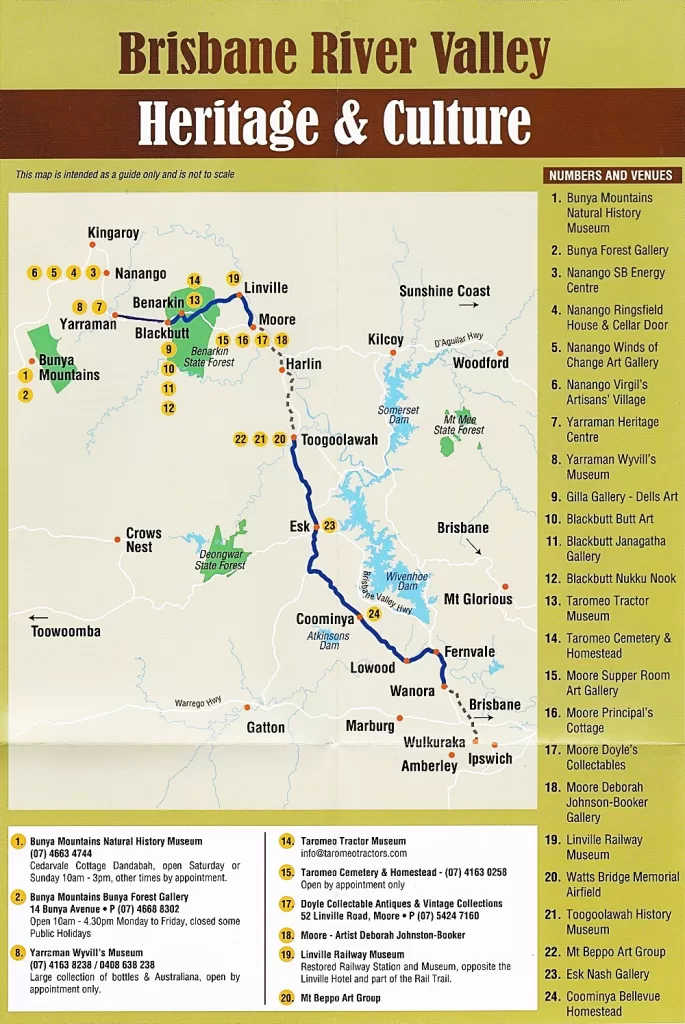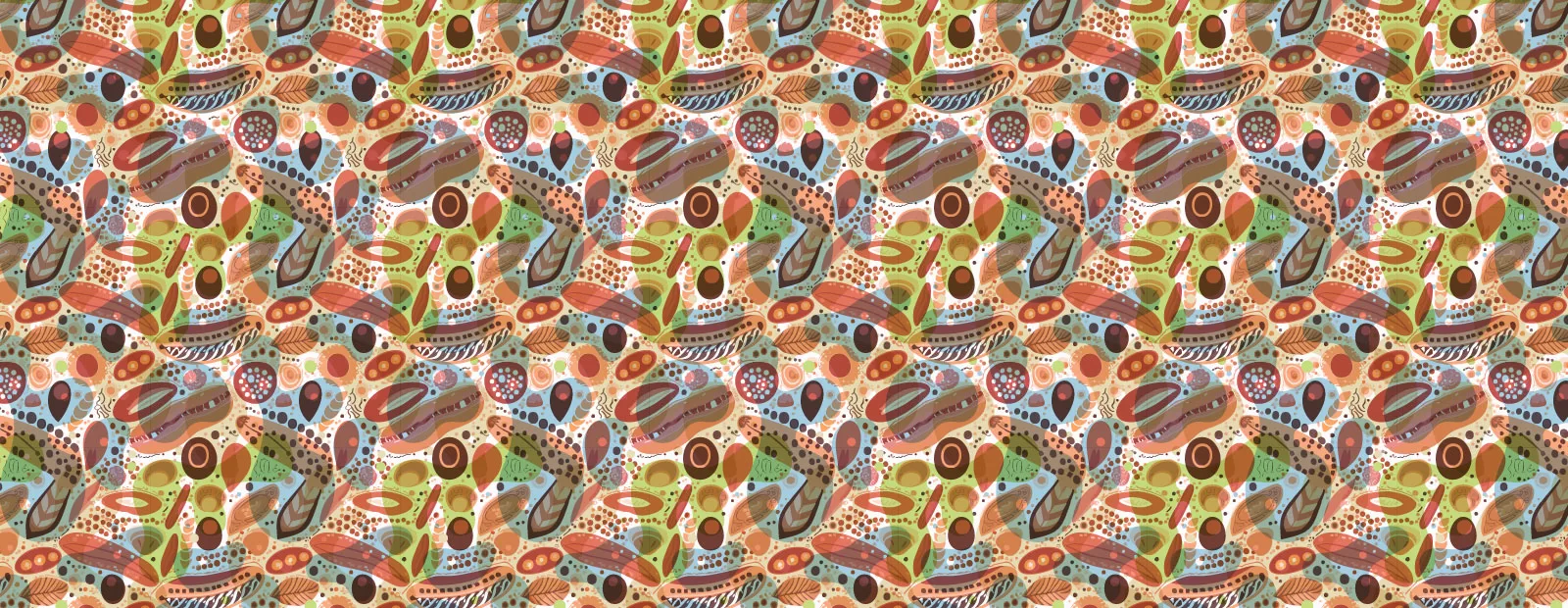
There are many old and heritage listed buildings on the heritage trails of the Brisbane Valley that are open to the public. They include the homesteads that were built by the prosperous owners of large land holdings in the late nineteenth century to accommodate a family that did not intend to return to Britain to live. In general they replaced the original buildings of the pioneers who established the properties. Only two workmen’s cottages remain – one at Caboonbah homestead on the road to Somerset Dam and another that was relocated from Colinton Station to Ringsfield House, Nanango.

The first of these houses in the Brisbane Valley is Bellevue Homestead at Coominya that housed both the North and the Lumley-Hill families on property now under the waters of the Wivenhoe Dam. Before it was inundated, the homestead was relocated to its present site at Coominya township and taken over by the National Trust. It is now in private hands and is open to the touring public at Coominya on the weekends (Phone 07-5426 4209). Its history has been impeccably recorded and easily recreated by local guides keen to note the gauzed verandahs and the ghost as well as the formal rooms of the British aristocracy with the financial resources to make their colonial experiences comfortable. A vineyard has been replanted at Bellevue and local wines will be available to complement the existing dining facilities.
Although Fernvale and Lowood have a fascinating history, they have both been subjected to catastrophic flooding from the Brisbane River and the old buildings have disappeared. The beautifully restored Nash Café in the main street of Esk is the next stop. It was the home of Lars Andersen, a well-known and very successful Sawmiller who milled timber from the Bunya Mountains as well as the districts around Mt. Byron, Esk and Toogoolawah. He was also a builder and the local Esk undertaker in the later 1800s and he built the Lowood Community Hall in 1893 and the Caboonbah Undenominational Church in 1905. He is best known for the development of tramways to take timber from inaccessible places in the mountains to waiting bullock wagons for transport to his mills. He is one of the pioneers of the timber trails in the Brisbane Valley and his home is heritage listed. It is currently open as a restaurant and its history is on display in posters throughout the building.
There are three buildings designed by Robin Dods in the Upper Brisbane Valley and the first of these is at Toogoolawah. St. Andrew’s Anglican Church in Toogoolawah is a beautiful example of Dods’ work, with a steep shingled roof. It is open for Sunday service and at other times by appointment. Contact details can be obtained from Esk Visitor Information Centre. The manse beside this church is also on the Queensland Heritage Register.
A private chapel in the grounds of Cressbrook Station called Victoria Chapel is another building designed by Dods, but this is in private hands and is not open to the public. It is situated a short drive from Toogoolawah. Some historical information about the McConnel family, who still owns this property and has done so since 1841, is available at John Oxley Library, State Library of Queensland. There are two local publications available about this old pioneering family (The Bunya Tree and Scrambling in a Family Tree).
The third Dods’ House is Ringsfield House at Nanango. This is a very gracious old home that has served as a hospital and a women’s refuge and is now a museum, reflecting its chequered history. It was once the social hub of Nanango and it is beautifully restored and appointed. Ringsfield House is open to the public. For contact details phone Nanango South Burnett Energy Visitor Information Centre 07 4171 0100.
Between St. Andrews Anglican Church at Toogoolawah and Ringsfield House at Nanango there are several interesting buildings. The first is the Colinton War Memorial that was moved a public park beside a service station on the D’Aguilar Highway. This is all that is left of the flourishing township of Colinton that once boasted a Condensery employing forty four people. The war memorial was the first such memorial erected in Queensland outside a cemetery and was unveiled in its original position opposite the Colinton School of Arts on 18 January 1917 by the Member for Stanley, H.P. Somerset. It is inscribed with the names of the forty three men who enlisted for World War I from the Colinton area.
The next stop on this tour is at Linville. This was the next railway station after the township of Moore but the D’Aguilar highway now by-passes this community. It is necessary to turn off the main highway at Moore for Linville where there is an unusual war memorial in the shape of a pagoda designed and built by the Cross brothers, one of whom was a noted war artist. This memorial is situated near the restored Linville Railway Station and Museum and opposite the Linville Hotel which celebrated its centenary in 2004. This hotel was first built at the railway terminus of Moorabool beyond Toogoolawah in 1904 and was moved, probably by bullock wagon to its present site in 1911 when the trains had reached Linville. The publican then was Alex McCallum and he also had the mail coach contract to Nanango. Mail and passengers would arrive at Linville by train and continue further up the Brisbane Valley by McCallum’s coach. His brother, Pat McCallum was the longest serving postman in early Queensland, serving the sometimes inaccessible districts beyond Nanango and delivering mail by horse. Pat’s Grandson, Reg McCallum is the longest serving Mayor in Australasia and was still representing Nanango Shire in his eightieth year. The Linville Hotel is a fairly representative country hotel for 1904 and its history is linked with one of the most interesting families of the Upper Brisbane Valley. The hotel is still open for business.
Returning to the D’Aguilar highway beyond Moore is Stonehouse, a unique stone building opened as a hotel in 1880. It is heritage listed but it is not open to the public although its exterior can be seen quite clearly from the highway. This was the home of the Williams family who were stonemasons and who opened Stonehouse as a hotel but quickly lost their license after a fatal incident with an aboriginal man who had been served alcohol. Local legend suggests that revoking its license did not seriously interfere with business. Stonehouse was mentioned in the folksong, ‘The Brisbane Ladies’ (see Stockroutes) and was the last coach stop before the difficult climb up the Blackbutt Range to Taromeo Station, before the railway line was opened to Yarraman.
Yarraman Heritage Centre at Yarraman was originally a Convent for the Sisters of Mercy and is a large building with beautiful stained walls of Crows Ash. Built at the height of the timber boom for the area, its interior architectural design is both Spartan and beautiful. This museum houses an eclectic series of displays including one that documents the history of electricity in the district. It is also the site of the local radio station. In the grounds of this museum stands the restored relocated Yarraman railway station and a butcher shop.
It is just a short drive from Yarraman to Nanango and Ringsfield House that was the last of the Robyn Dods’ buildings in the Brisbane Valley and mentioned previously. This very large home has been faithfully restored and furnished to reflect its diverse history. Ringsfield House provides an interesting comparison with Bellevue Homestead that also reflects English manners and customs. It also helps to demonstrate the class divide at the turn of the twentieth century with the contrast between a sawmiller’s home at Esk and a stately home at Nanango.
The final comparison on class lines must be between this home and the Colinton Shepherd’s hut that also stands in the grounds of Ringsfield House. The hut is small, functional and dry. Perhaps it is not surprising that 43 working men from accommodation such as this in the Colinton district enlisted in WWI. From such humble beginnings any change must have been an adventure, and any opportunity for improvement worth the risk. This diverse tour of some of the heritage buildings of the Brisbane Valley reflects the hopes and the achievements of all those we are proud to call pioneers.

